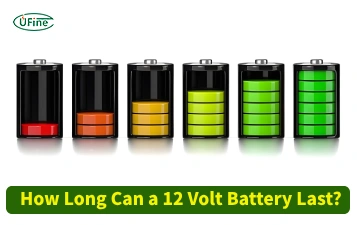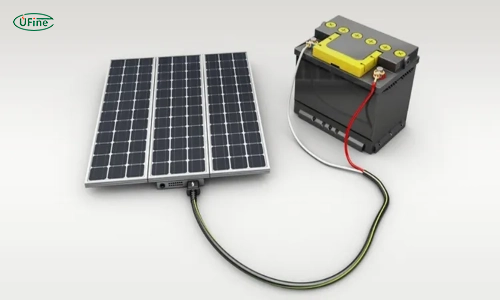Are you curious about solar batteries and how they work? This guide has you covered! We’ll explore what solar batteries are, the types available, and how to choose the right one. Plus, we’ll share easy tips for installation and maintenance. Let’s start.
Part 1. What are solar batteries?
Solar batteries are essential components of solar energy systems, storing excess energy generated by solar panels for later use. They serve as reservoirs, capturing sunlight during the day and providing power when solar panels don’t produce electricity, like at night or on cloudy days.
How Solar Batteries Work:
When sunlight hits the solar panels, it generates DC (direct current) electricity. This electricity flows into the solar battery, storing it as chemical energy. When you need electricity, the stored energy is converted into DC electricity and sent to power your home or business.
Storage and Delivery Process:
Solar batteries use charge controllers to regulate the flow of electricity, preventing overcharging and maximizing efficiency. They come in various sizes and capacities, allowing you to choose the right one based on your energy needs. Some advanced solar batteries even have intelligent features, like remote monitoring and control, to optimize energy usage and savings.
Part 2. Types of solar batteries
Lead-Acid Batteries
Lead-acid batteries are traditional rechargeable batteries that use lead dioxide as the positive electrode and sponge lead as the negative electrode. They operate on converting chemical energy into electrical energy and vice versa during charge and discharge cycles.
People commonly use lead-acid batteries in off-grid solar systems, backup power systems, and small-scale renewable energy installations.
Pros:
- Affordable, upfront cost
- Well-established technology with reliable performance
- Suitable for rough handling and deep discharges
Cons:
- Limited cycle life compared to lithium-ion batteries
- Requires regular maintenance such as watering and equalizing
- Lead-acid batteries have lower energy density and are bulkier than lithium-ion batteries.
Lithium-Ion Batteries
Lithium-ion batteries are rechargeable batteries that use lithium ions as the primary carrier of energy. Standard lithium-ion chemistries used in solar applications include lithium iron phosphate (LiFePO4), lithium cobalt oxide (LiCoO2), and lithium nickel manganese cobalt oxide (NMC).
장점:
- High energy density, providing more energy storage in a smaller size
- Longer lifespan compared to lead-acid batteries
- Low self-discharge rate and minimal maintenance required
단점:
- Higher initial cost
- Safety concerns related to thermal runaway and fire hazards
- Limited availability of recycling infrastructure for lithium-ion batteries.
Flow Batteries
Flow batteries store energy in liquid electrolytes stored in external tanks. They are suitable for large-scale energy storage applications due to their scalability and long cycle life.
Comparison:
- Flow batteries offer higher efficiency and longer lifespan than lead-acid and lithium-ion batteries.
- However, they have higher upfront costs and require more space due to the separate electrolyte tanks.
- Flow batteries excel in applications requiring frequent deep discharges and long-duration energy storage, such as grid-level energy storage and renewable energy integration.
Part 3. Factors to consider when choosing solar batteries
용량:
- Determine your energy needs and choose a solar battery with sufficient capacity to meet your daily energy consumption.
- Consider factors such as the size of your solar system, household energy usage patterns, and potential future expansion.
수명:
- Evaluate the battery’s lifespan, typically measured in cycles or years, and choose one that balances upfront cost and long-term durability.
- Lithium-ion batteries generally have a longer lifespan than lead-acid batteries. Still, they may come with a higher initial investment.
Depth of Discharge (DoD):
- Check the battery’s discharge depth, indicating how much capacity you can use before recharging.
- Higher DoD values allow more energy storage and utilization but may impact the battery’s lifespan.
Efficiency:
- Consider the efficiency of the solar battery, including both charging and discharging efficiency.
- Look for batteries with high round-trip efficiency, which measures how much energy they retain after charging and discharging cycles.
Part 4. Solar battery installation and maintenance
Installation Process:
- Begin by selecting a suitable location for the solar battery, preferably indoors or in a protected outdoor enclosure.
- nsure the area is well-ventilated, away from direct sunlight, extreme temperatures, and moisture.
- Follow the manufacturer’s instructions for mounting and securing the battery using appropriate hardware and supports.
- Connect the battery to your solar system’s charge controller and inverter using compatible cables and connectors.
Electrical Wiring:
- Carefully wire the solar battery to your solar panels, charge controller, and inverter, following electrical codes and safety guidelines.
- Double-check all connections to ensure they are tight and secure, minimizing the risk of electrical faults or accidents.
Commissioning and Testing:
- After installation, commission the solar battery by initializing it according to the manufacturer’s instructions.
- Test the battery’s performance and functionality by charging and discharging it under different load conditions.
- Monitor the battery’s voltage, current, and temperature during operation to ensure optimal performance and safety.
Maintenance Routine:
- Establish a regular maintenance routine to keep your solar battery operating efficiently and prolong its lifespan.
- Inspect the battery terminals and connections for signs of corrosion, loose connections, or damage, and clean them as needed.
- If necessary, check the electrolyte levels in lead-acid batteries and top them up with distilled water.
- Monitor the battery’s state of charge and voltage regularly and recalibrate if you notice deviations.
Temperature Control:
- Implement temperature control measures to protect the solar battery from extreme temperatures, which can affect its performance and longevity.
- Install insulation or thermal barriers around the battery enclosure to regulate temperature fluctuations.
- Consider using active cooling or ventilation systems to dissipate excess heat and maintain optimal operating conditions.
Emergency Preparedness:
- Develop an emergency response plan in case of power outages, equipment failures, or other unexpected events.
- Keep backup power sources, such as generators or portable battery banks, on hand to provide temporary power during emergencies.
Part 5. Integration with solar systems
System Design
Factors to Consider:
- Determine the size and capacity of the solar battery based on energy consumption patterns, daily load requirements, and available sunlight.
- Ensure compatibility between the solar battery and existing solar PV components, including panels, charge controllers, and inverters.
- Consider the type of solar system: off-grid, grid-tied, or hybrid, and design the integration accordingly.
Design Considerations:
- For off-grid systems, the solar battery should be sized to provide enough energy storage to meet power needs during periods of low sunlight or high demand.
- Grid-tied systems require inverters capable of synchronizing with the utility grid and managing energy flow between the solar panels, battery, and grid.
- Hybrid systems combine the benefits of off-grid and grid-tied setups, requiring sophisticated control systems to optimize energy production and storage.
Charge Controllers and Inverters
Role of Charge Controllers:
- Charge controllers regulate the flow of electricity between the solar panels and the battery, preventing overcharging and optimizing charging efficiency.
- They come in two main types: PWM (Pulse Width Modulation) and MPPT (Maximum Power Point Tracking), each offering different performance characteristics.
Role of Inverters:
- Inverters convert DC (direct current) electricity from the solar panels and battery into AC (alternating current) electricity usable by household appliances and the grid.
- They also manage the synchronization of the solar system with the utility grid in grid-tied installations, ensuring seamless energy transfer.
Types of Controllers and Inverters:
- Choose charge controllers and inverters compatible with the battery chemistry used in the solar system, such as lead-acid, lithium-ion, or flow batteries.
- MPPT charge controllers are more efficient than PWM controllers, particularly in systems with varying sunlight conditions or shading.
- Select inverters with the appropriate voltage and power rating to match the solar panel array and battery bank, ensuring optimal system performance.
Part 6. FAQs
-
Do solar batteries work during cloudy days?
Yes, solar batteries can still store energy from sunlight even on cloudy days, although their charging capacity may be reduced. They are designed to capture and store excess power generated by solar panels for later use. -
Can I install a solar battery myself?
While some solar batteries are designed for DIY installation, hiring a professional installer is recommended to ensure proper setup, wiring, and compliance with safety regulations. Improper installation can affect performance and safety. -
How long do solar batteries last?
The lifespan of a solar battery depends on factors such as battery chemistry, usage patterns, and maintenance. Generally, lithium-ion batteries have a longer lifespan than lead-acid batteries, lasting anywhere from 5 to 15 years or more. -
Are solar batteries environmentally friendly?
Solar batteries contribute to sustainability by storing clean, renewable energy and reducing reliance on fossil fuels. However, the environmental impact varies depending on the battery chemistry and manufacturing processes. Lithium-ion batteries, for example, require careful disposal and recycling to minimize environmental harm. -
Can I use solar batteries to go completely off-grid?
Yes, solar batteries can enable off-grid living by storing excess energy generated by solar panels for use during periods of low sunlight or high demand. However, careful planning and sizing of the solar system and battery bank are necessary to ensure reliable power supply throughout the year.
관련 태그:
더 많은 기사

12 Volt Batteries: How Long Can They Really Last?
Discover how long a 12-volt battery lasts, factors affecting its lifespan, and tips to extend its life.
Upgrade Your Drill Battery to Lithium Batteries
Discover why switching from Ni-Cd to li batteries for your drill is essential. Learn about battery types, comparisons, and how to choose the best drill battery.
Everything You Need to Know About Group 26 Batteries
Discover the ins and outs of Group 26 batteries, including types, dimensions, prices, and maintenance tips. Learn where to buy the best Group 26 battery.
Recommended 10 Leisure Batteries for Motorhomes or Caravans
Traveling in a motorhome or caravan? A good leisure battery is essential. Avoid power issues with our guide to the top 10 best leisure batteries for this year.
Top 10 Truck Battery Options to Keep You Rolling Strong
Struggling with weak truck batteries? Avoid breakdowns with our guide to the top 10 truck batteries, ensuring durability and high performance for any journey.




